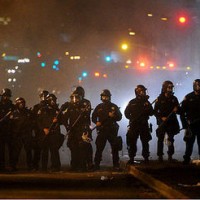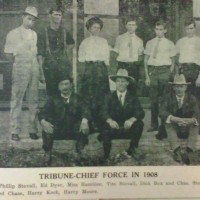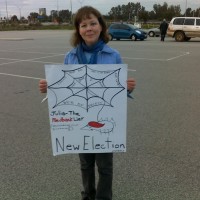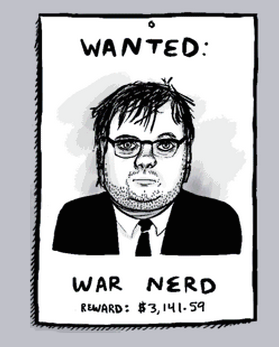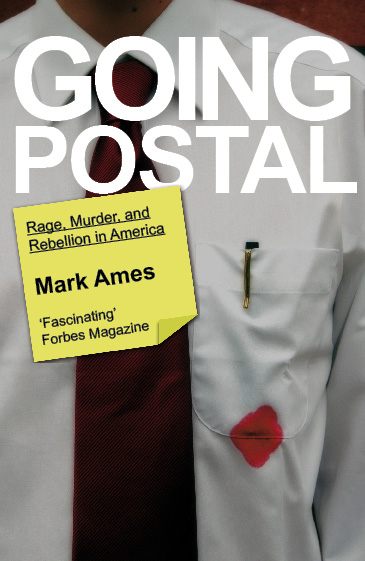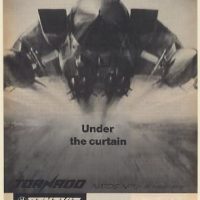
This article is cross-posted from WitnessLA.com with permission of the author Matt Fleischer. Read his other reports on LA’s violent and abusive criminal justice system: Part I, Part II and Part III.
***
LASD insiders say that, for years, Undersheriff Paul Tanaka—not Lee Baca—has ruled the Los Angeles Sheriff’s Department though a system built of favoritism, pay-to-play campaign donations, and loyalty rewarded over competence.
Now he has assumed command of the department’s two internal investigative units—Internal Affairs and the Internal Criminal Investigations Bureau—a move that many close to the department view as a hostile takeover.
On May 15, 2011, the Los Angeles Sheriff’s Department quietly made a series of small, seemingly innocuous changes to its command structure. The Internal Affairs unit, which investigates violations of departmental policy, and the Internal Criminal Investigations Bureau, which looks into criminal acts that may have been committed by department personnel, were taken out from under the oversight of the Leadership and Training Division—where the twin divisions have been for nearly two decades—-and were placed under the control of the then-Assistant Sheriff, soon-to-be- Undersheriff, Paul Tanaka. In practical terms, this meant that, instead of the heads of the two bureaus reporting to Leadership and Training’s Chief, Roberta Abner, Tanaka appointed a brand new captain and commander from his own inner circle to head IA and report to him. At the same time, he selected a new captain to run ICIB, also reporting to him. Abner was taken out of the loop altogether, and a commander position overseeing ICIB was eliminated. Two levels of oversight and accountability in the system with which the department investigated itself vanished overnight.
To the casual observer, the moves might appear to be little more than the bureaucratic shuffling of departmental chess pieces. But to those inside the sheriff’s department, the sudden switch in oversight was alarming. As one former IA investigator explained, “To have a commander and a captain reporting directly to the Undersheriff…there’s no precedent for that.”
In order to check, the LA Justice Report called around to five law enforcement agencies across California—San Diego Sheriff’s Department; Orange County Sheriff’s Department; San Francisco Sheriff’s Department; Los Angeles Police Department; and the San Francisco Police Department–and found that only the SFSD has its “investigative services” unit report directly to someone as high up as the undersheriff without intervening layers. “We’re much smaller than LASD,” explained an SFSD spokesperson, “we only have about 850 employees. So it makes things more manageable.”
In a department of 18,000, like the LASD, the layered chain of command existed for good reason, according to our IA source (and validated by other department insiders with IA knowledge). “Personnel investigations are extremely in-depth. IA is a relatively large unit, with 35-40 people in it. You have to have time to oversee and manage them. But the undersheriff has constantly got an 800 pound gorilla banging on his head.”
So why the change?
LASD spokesman Captain Mike Parker explained in an email that the move was simply so the Sheriff could keep a better eye on the two bureaus. “All reorganization changes within the Los Angeles County Sheriff’s Department are done at the direction of Sheriff Baca…Recent changes have been made to the oversight of Internal Affairs Bureau and Internal Criminal Investigations Bureau to increase accountability and efficiency, and to streamline the process.”
However, sources inside the department say the move had little to do with increased accountability, but rather was a realignment that allowed the undersheriff to protect any of his insiders that needed protecting.
As The LA Justice Report has previously reported, Tanaka has a history of rescuing, promoting and protecting supervisors with less-than-spectacular and often downright troubled performance records, people who then become his most loyal supporters.
There was, for example, Dan Cruz, the highest ranking member of the Sheriff’s Department to be put on leave for his role in the recent jail abuse scandal—and also a Tanaka appointee and loyal donor to the undersheriff’s political campaign in Gardena. Cruz arrived at CJ as an operations lieutenant with a checkered supervisory record. Nonetheless, he was promoted to captain and put in charge of the already troubled Men’s Central Jail. Deputy-on-inmate force incidents spiked almost immediately under his watch. The situation was desperate enough that Cruz’s direct supervisor, Commander Bob Olmsted, told Tanaka directly of problems inside the jail under Cruz—and told Lee Baca as well. Olmsted says he was ignored.
If supervisors like Olmsted came to Tanaka with reports of uncontrolled violence and were waved away, how will the undersheriff respond to critical IA and ICIB investigations into favored people and groups his department?
“I think we should be concerned,” says the ACLU’s Peter Eliasberg. “The reality is that one of the key components in dealing with deputy use of force on inmates is a system that provides for appropriate discipline of deputies. If you have someone at the top overseeing that system who’s not aggressively committed to policing what deputies are doing, that’s a very bad thing.”
KEEP YOUR ENEMIES CLOSER
Part of the problem with the undersheriff’s takeover of the two bureaus, sources tell the LA Justice Report, is the fact that Tanaka has openly, and vociferously, expressed his contempt for IA throughout his career.
In early 2007, LASD Internal Affairs Sergeant Larry Landreth was named the lead investigator of an extremely sensitive case. An LASD deputy trainee had been caught on a wiretap allegedly giving information to the Mexican Mafia. The incident had the makings of a huge scandal for the department, and the brass were all over Landreth to look into this case as quickly and as thoroughly as possible.
Shortly before the investigation began, Paul Tanaka—who was then the assistant sheriff–called Landreth into his office for a closed-door meeting. The meeting began in a normal manner. Tanaka stressed the importance of the case, and gave Landreth his blessing to investigate aggressively.
Tanaka then said something Landreth wasn’t expecting. “He looked at me straight-faced,” Landreth, now retired, tells the LA Justice Report, “and said ‘This is the only time you’re going to see me be an advocate of IA, because I hate you fuckers.’
Startled by the outburst, Landreth scanned Tanaka’s face for a trace of humor but found none.
“You take pride in your job,” says Landreth, “and to be called a ‘fucker’ to my face out of nowhere…It was an affront.”
He asked Tanaka what, exactly, his problem was with Internal Affairs? Landreth and his colleagues had noticed that Tanaka seemed unwilling to promote out of IA–despite the unit being among the most important in the department, and traditionally considered a career enhancing stepping stone in the LASD.
Landreth says he reminded Tanaka that the purpose of IA was far more than proving wrongdoing. It was also bureau in the department with the power to protect innocent deputies who get falsely accused of misbehavior—which happens, says Landreth “all the time.” It is IA’s job to launch the investigations that clear these deputies’ names.
“It is just as important to free the innocent as it is to punish the guilty,” says Landreth.
But Tanaka wouldn’t hear any of it. Pressed by Landreth, Tanaka muttered vaguely that he’d had some bad run-ins with IA back in the 80’s–and that soured him on the unit. He referenced an incident at Men’s Central Jail early in his career, but provided no details.
THE SHOOTING
Tanaka’s worst “run-in” with IA in the 1980s is well known. In 1988 he was the senior officer on the scene when five Sheriff’s deputies shot and killed an unarmed Korean immigrant named Hong Pyo Lee after a car chase found Lee cornered at a dead-end street. The group of deputies fired fifteen rounds at 21-year-old Lee, hitting him 9 times in the back and neck. Tanaka and the other four deputies claimed they shot because Lee was attempting to hit them with his car. However, Long Beach police officer Richard R. Boatwright, who witnessed the shooting, said in a sworn deposition that Lee’s car was moving away from deputies when the shooting began. “We just observed the sheriffs execute somebody,” Boatwright said he told his partner. LA County paid Lee’s family $1 short of a $1 million in a settlement after the shooting.
Then in 1993, sources tell us, Tanaka was reportedly shipped to West Hollywood station as a disciplinary measure for using harsh and inappropriate language to berate a female deputy at Century station, where Tanaka was a lieutenant.
“He’s been carrying a grudge around for more than 20 years,” says Landreth. “That should not be the position of any department head.” And certainly not the man leading the department’s two internal investigative units.
The encounter with Landreth is one of a number of occasions in which Tanaka reportedly badmouthed IA in front of other department personnel. In 2005, Tanaka called a “deputies only” meeting at Century Station in Inglewood, which was, at the time, struggling with violence stemming from a deputy gang called The Regulators—who, like the better known deputy gang of the 1980s to 1990’s era, the Vikings, were notorious for finding weak supervisors they could gang up on and control. Tanaka’s message to this troublesome group: “I never liked IA. Never liked the way they do business.”
“He signs off on discipline,” says a department source familiar with Century Station and the Regulators, “he can’t say that.”
Century’s captain at the time, Steve Roller, agreed—and wrote a memo critical of Tanaka’s statements that he sent up the chain of command. The memo was harsh enough, sources say, that Lee Baca himself visited Century to do damage control.
A few months later, Roller was unexpectedly transferred out of Century while away on an Alaskan cruise. Several sources tell The LA Justice Report that it was the captain’s aggressive, by-the-books ways that got him ”rolled up”—as it was a supervisory style that clashed with Paul Tanaka’s vision for how to run a high profile station like Century.
As we reported in Dangerous Jails, Part 3, department sources cite multiple incidents in which Undersheriff Tanaka has told deputies in the department to “work in they grey”—a skate the edge style of policing that essentially translates to “do whatever it takes.”
The LA Justice Report spoke with three former IA investigators who each made clear that “working in the grey” policing, and aggressive internal affairs monitoring of departmental wrongdoing are irreconcilable. Robust internal affairs and deputies told by their undersheriff to push the boundaries of departmental policy cannot coexist. Something has to give. And by all accounts, when it comes to Paul Tanaka, it will be IA, not the deputies under his wing who are forced to cede ground.
HANDCUFFING THE ADULTS
An example of the slippery slope that comes with ceding this supervisory ground occurred in 2006, when Paul Tanaka called an impromptu meeting for all the supervisors inside Men’s Central Jail. Tanaka was then the assistant sheriff in charge of custody and the meeting was not unexpected. There had been a string of high profile violent incidents in the jail that had drawn the scrutiny of the LA County Board of Supervisors, the ACLU and the media.
As The LA Justice Report has previously reported, CJ’s then-captain John Clark traced much of the violence back to bands of deputies who were forming gang-like cliques on the second, third and fourth floors of the jail—the 3000 Boys, et al. Modeled after the law-suit producing deputy cliques of the previous decades, like the Vikings, these cliques featured special tattoos, threw gang-like hand signs and, in some cases, refused to socialize with “rival” cliques within the department. In the case of the 3000 Boys and the matching group from the 2nd floor, the 2000 Boys, the cliques had also recently started waiting for their entire crew to get off work—sometimes lingering for hours at a time—before leaving the station together en masse. This was not only a violation of departmental policy, but it was eerie gang-like behavior intended to intimidate—to show both inmates and supervisors alike who really ran the jail.
“You had guys taking off one or two hours early so they could leave with their crew,” says one former CJ supervisor (who asked that we not give his rank for fear of being identified). “This is what gangs do.”
It was in this climate, that Paul Tanaka called his meeting. Our source, who was in the room that day, tells us that, instead of demanding better supervision of the increasingly out-of-control deputies—whose actions have now been reported by The LA Justice report here, along with the ACLU, the LA Weekly, KTLA and the LA Times, not to mention an ongoing series of high ticket law suits, and an investigation by the FBI—Tanaka told everyone to back off.
“I want you supervisors to stay out of the way and let the deputies do their jobs,” Tanaka said. “Your type of supervision is like a dinosaur. You remind me of my father.”
Our source says Tanaka was particularly livid at the suggestion that deputies in cliques like the 3,000 Boys were acting like gangsters. “How dare any supervisor refer to a Los Angeles Sheriff’s Department deputy as a gang member.”
Tanaka then made a cradling gesture with his hands. “This is Generation Y. You will coddle these men.”
Our source says that he and his fellow CJ supervisors were shocked at the counter-disciplinary instructions. Here was one of the most powerful men in the department essentially telling them to not do their jobs—not to provide boundaries, and guidance for these inexperienced deputies. Many of these men and women were a few months out of the Sheriff’s Academy and were not just risking doing harm to inmates, but also—if their mistakes were big enough— potentially sacrificing their careers. This is why a big law enforcement agency like the Los Angeles Sheriff’s Department have structural fail safes: Just because the assistant sheriff wanted lax supervision, didn’t mean IA or ICIB couldn’t investigate these same deputies for wrongdoing, if their actions were serious and well documented.
.
“We weren’t trying to be autocratic,” says our source. “We’re a paramilitary organization. There are rules and regulations. We need discipline. And that discipline had broken down.
“Tanaka’s intervention put handcuffs on all of us.”
Sources tell us Tanaka’s hands-free management style is nothing new—it dates back to his days as a sergeant at Lynwood station in the late-80’s early 90’s. According to a source who worked at Lynwood, Tanaka was the supervisor of choice for deputies who were “sergeant shopping”—looking for a supervisor mostly likely to give permission or protection. This was particularly true with members of the Vikings, of whom Tanaka was, by then, a tattooed member.
[For more on the undersheriff and the Vikings see below]
Since Tanaka was just a sergeant, back then, he wouldn’t have had the “juice” to head off something as serious as an IA investigation. But in basic disciplinary battles between deputies and fellow sergeants, Tanaka nearly always sided with deputies—in the process, eroding the authority of supervision at the station.
“He was emotionally close with these guys,” explains our source. “They bonded. He was one of them. He was too immature and not intellectually aware enough to realize the inherent problems with this arrangement. Departmental standards were not being enforced.”
“They’d go running to him like Mommy,” says another LASD source from Tanaka’s Lynwood days. “Tanaka sold out his fellow supervisors to curry favor with the Vikings. It breeds arrogance on steroids. Because these guys know, even if they’re in the wrong, someone has their back. It’s the same story today with the 3,000 Boys. This is a pattern with Tanaka.”
CONTROL ISSUES
So why does a man who has repeatedly made known to all his dislike of Internal Affairs, and aggressive supervision of deputies, suddenly wish to have power over over the unit responsible for investigating departmental misdeeds?
The three former LASD Internal Affairs investigators we spoke to all told us versions of the same thing: “It’s about control.”
These former IA investigators, as well as other sources inside the department, point to the questionable timing of Tanaka’s takeover—a few weeks after his high school friend Bernice Abraham was put on leave when federal investigators notified Sheriff’s officials that Abram’s voice may have been heard on a narcotics wiretap relating to an investigation of a Compton drug ring. Abram had been the head of Carson Station and a close ally of Tanaka. She has contributed to his Gardena political campaigns since 2004.
“Ever since Abram was relieved of duty, things changed,” says one LASD supervisor.
According to the supervisor, prior to Tanaka’s takeover of IA and ICIB, whenever someone in the department was arrested or put on leave, a departmental memo called a “confidential operational log,” which summarized the circumstances surrounding the action, would go out to LASD supervisors with the rank of captain or higher. However, a confidential operational log was never sent out about Abram, nor, according to our insider, have any others been sent since Tanaka became Undersheriff.
“People inquiring about [Abram], mostly out of concern, were quickly told to ‘mind their own business.’
“All this did was weaken trust within the department,” he says. “There was no more transparency and many felt, and feel, that there is something to hide, not only as it relates to Bernice Abram, but to others and any potential future investigations.”
“It was standard operating procedure, no big deal,” says another former LASD higher-up of the confidential operational logs, “the way business was done. Now it’s all about trying to stifle information from getting outside the organization.”
DOUBLE STANDARDS
Multiple sources tell us they worry there is a standard of permissiveness for some people—namely Tanaka insiders—-that doesn’t apply to others in the department. They argue that there were instances of the Undersheriff and other LASD brass applying pressure on IA investigations even before Tanaka took direct control of the bureau. As an example, they point to an investigation into theMay 9, 2005 shooting of Winston Hayes by LASD deputies. Hayes was a black motorist who, high on drugs, led Sheriff’s deputies on a low-speed pursuit through Compton. Deputies eventually pulled Hayes over, and advanced in his direction. Then, claiming he tried to run them down, deputies fired 120 shots at Hayes’ car, hitting him nine times and his vehicle 66 more times. In the crossfire, the deputies also managed to shoot one of their own officers (non-fatally), plus strafe several squad cars with 11 rounds. Another 11 bullets slammed into surrounding homes.
The incident prompted a gigantic community backlash and cost LA County $1,326,468.60 when a jury, after watching a citizen video of the incident, agreed that officers had used excessive force on Hayes, who miraculously survived the barrage. All deputies involved in the incident were given 15-day suspensions stemming from an Internal Affairs review, as was the sergeant who directed the chase over the police radio.
Yet two different sources tell us that the watch commander on the incident, a lieutenant out of Compton station, not only escaped any kind of sanctions, he was never made a subject of investigation by Internal Affairs—despite the fact that he was in the field and on the radio during the chase. According to our sources, this lieutenant upped the urgency of the chase by hopping on the radio to list Hayes’ past crimes as events were still unfolding.
“He absolutely inflamed the situation,” says one LASD insider with knowledge of the incident.
Sources say IA investigators attempted to interview the lieutenant as a subject, but were pressured by higher-ups to stay away. Landreth was one of the lead IA investigators on the Compton shooting, and he confirms our sources’ story. Departmental policy and the Policeman’s Bill of Rights prevent Landreth from discussing the case with us in detail, or naming the lieutenant in question, but other sources tell us the lieutenant was James Hellmold—one of Paul Tanaka’s leading campaign contributors and a former driver to Sheriff Lee Baca.
“Tanaka and Baca put Hellmold off in the corner and let the Sergeants take the fall,” says a former high-ranking insider with knowledge of the situation. “He absolutely should have been the subject of an IA investigation.”
Hellmold’s free pass earned him the nickname “Teflon Lieutenant” among those with knowledge of the shooting. A little more than a year after the incident, Hellmold was promoted to captain and placed in charge of Century Station. He has since risen to the rank of commander and is one of four commanders leading Baca’s panel to investigate jail violence.
However, Hellmold’s Teflon dodge happened under the old IA system–where an investigator like Landreth had the option going to his chief to try to earn the backing of a command staff ally. Under the new system, the only recourse an investigator would have would be to go straight to Paul Tanaka.
“If he’s stacking the deck with ‘his’ people in there,” says one former Internal Affairs investigator, “then I don’t have any faith in IA.”
EPILOGUE
On December 19 of 2011, the LA Justice Report submitted a series of questions to the LA Sheriff’s Department regarding Paul Tanaka’s takeover of Internal Affairs and Internal Criminal Investigations Bureau—and his notorious dislike for IA.
On January 4, 2012, two weeks after our conversation with Parker, Internal Affairs was put back under the umbrella of Chief Roberta Abner and the Leadership and Training Division. Internal Criminal Investigations remains under the control of Undersheriff Tanaka. How much or little unofficial influence over Internal Affairs that Paul Tanaka retains is unknown.
***
Editor’s Notes:
TANAKA & THE VIKINGS
Tanaka throwing up the Lynwood Vikings “L” sign
In 1987, the year before the Hong Pyo Lee shooting, Paul Tanaka was asked to join the Vikings, the now notorious group of deputies operating out of the Lynwood station, whose members sported numbered Viking tattoos on their ankles, threw gang signs—L for Lynwood—occasionally spray-painted Vikings tags in the Lynwood area to mark their “turf,” and bragged openly about harassing supervisors who tried to reign them in until those supervisors transferred away from Lynwood. Tanaka was one of the group’s very few non-Caucasian members.
In the early 1990’s, members of the same Lynwood Vikings were the primary defendants in a massive class action suit against the department alleging a widespread pattern of brutality against Lynwood residents.
The suit resulted in a $9 million settlement and drew unusually harsh “findings of fact” from two sets of presiding judges.
U.S. District Court Judge Terry Hatter stated that a “neo-Nazi, white supremacist gang” of deputies–the Vikings–exists at the Lynwood station with the knowledge of department officials. “Policy makers” in the department, Hatter said, “tacitly authorize deputies’ unconstitutional behavior.”
The 9th Circuit Court of Appeals agreed. These deputies, wrote the 9th Circuit of the Lynwood Vikings, “…regularly disregard the civil rights of individuals they have sworn to protect.” They engaged in misconduct “both malicious and pervasive…” Black and hispanic men were “repeatedly arrested without cause and severely beaten at the Lynwood station, the County jail, and the ‘Operations Safe Streets’ trailer.” The court described “instances where deputies placed the muzzle of a firearm in a suspect’s ear, mouth or behind his head, and threatened to pull the trigger, or actually fired the gun without discharging a bullet…” and more.
The list of court-determined “facts” went on and on..
Tanaka was already a Viking at the time the lawsuit was filed, but was not one of those named in the complaint. However, we spoke to two of the attorneys who filled the lawsuit, as well as to department insiders with direct knowledge of the Vikings, all of whom confirmed Tanaka’s involvement with the group during his Lynwood years.
“[Tanaka] was well known as a member of the Vikings and what they stand for,” said former LASD lieutenant, Roger Clark. Now retired, Clark acts an expert witness who is frequently called to testify about his knowledge of law enforcement subcultures and what he calls “peer clans,” like the Vikings and the 3000 Boys. “There’s always been a tension in the department between people who are willing to bend the rules and those who are not.” Undersheriff Paul Tanaka, said Clark, falls firmly on the rule-bending side of the equation.
This article is cross-posted from WitnessLA.com with permission of the author Matt Fleischer.
That was part four of a WitnessLA.com Justice Report project, created in partnership with Spot.Us. Read the rest here: Part I, Part II and Part III.
Posted on: January 23rd, 2012 | Comments (14)







